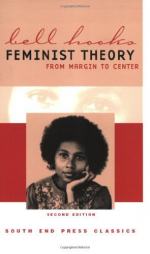
|
| Name: _________________________ | Period: ___________________ |
This test consists of 5 short answer questions, 10 short essay questions, and 1 (of 3) essay topics.
Short Answer Questions
1. In Chapter 1, the author states that feminist theory and the feminist movement were originally shaped by which type of people?
2. What assertion does the author make (once again) about who benefits from the current feminist movement?
3. In Chapter Four, what does the author give as the broad definition of "sisterhood" from the early feminist movement?
4. As stated in the 1984 Preface, what is the primary weakness of feminist theory that the author promises to address in her book?
5. How does the author see feminism and the family?
Short Essay Questions
1. Is the lack of solidarity mainly an issue between black women and white women?
2. How does the title of Chapter One, "Black Women - Shaping Feminist Theory," relate to the content of the chapter?
3. Does the author encourage a particular attitude towards manifesting change?
4. In chapter Nine, "Feminist Movement to End Violence," how does the author describe the patriarchal perspective on gender.
5. What significant effect can feminism have on the family?
6. Describe the early feminist view on parenting stated in Chapter Ten, "Revolutionary Parenting."
7. Why is educating women a "feminist agenda," as the title to Chapter Eight suggests?
8. Compare the Preface to the second edition with Ch. 12: What similarities do you see regarding the author's vision for the future of the feminist movement? List two to three examples.
9. What is the traditional view on motherhood that the author relates in Chapter Ten?
10. In the Preface to the Second Edition (January 2000) entitled "Seeing the Light: Visionary Feminism," what does the author have to say about her specific approach to feminism and the reactions it created?
Essay Topics
Write an essay for ONE of the following topics:
Essay Topic 1
Essay on Ch. 9: Violence and the media.
Fighting violence against women has been one of the mainstays of the feminist movement since it's inception. One of the forms this has taken more recently, has been to address the problem through looking at media images that display violence against women.
1) The author claims that men and women are desensitized to violence. What are the repercussions of this phenomenon and how does she explain it?
2) In what ways does the media make violence against women seem normal? for example, by makig it sexually appealing, or associating it with love, etc.
3) Discuss several examples from film and other media, such as fashion magazines or video games, in which you have noticed images of violence against women. Analyze your examples.
4) Have you seen signs in the media that violence against women is discouraged? Discuss your examples.
Essay Topic 2
Essay on Ch. 12: The process of feminist-oriented change.
The final chapter of the book looks at the process of feminist-oriented change and what is required to enact that change. This essay will provide an overview of the author's critiques and her prescriptions for revolutionary feminist change.
1) Discuss the author's analysis of early feminist approaches to creating change. In what way do these approaches fall short?
2) Discuss the author's recommendation for enacting change: What kind of social analysis does the author call for? What kind of action does she call for?
3) Discuss the author's view of the process of change: What attitude is called for? Why is the process of change difficult for Americans in particular?
4) Do you believe that the change the author calls for is possible?
Essay Topic 3
Essay on Ch. 6: Traditional and alternative models of power.
In Ch. 6 the author elaborates on traditional and alternative models of power and their relationship to women and the feminist movement. Discuss the central points of her analysis.
1) First, provide a brief definition of traditional and alternative models of power.
2) Next, discuss how and why early feminists understood and reacted to power.
3) Follow with a discussion of the author's observation about these feminists' ambivalent relationship to male-defined models of power.
4) Finally discuss how and why the author sees women of color and working class white women as examples of alternative models of power.
5) How do you view her assessment?
|
This section contains 1,115 words (approx. 4 pages at 300 words per page) |

|




